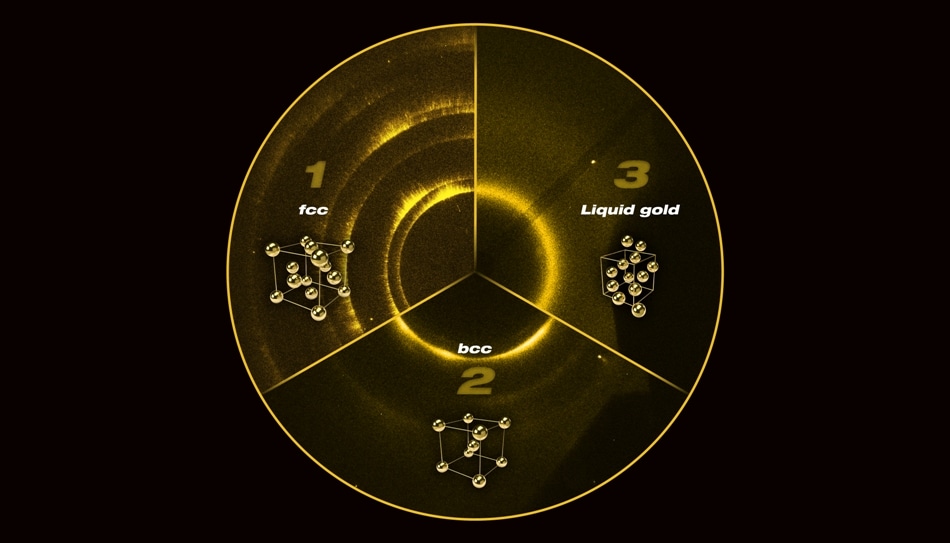Jul 31 2019
In high-pressure experiments, gold is a very important material, and in static diamond anvil cell experiments, it is regarded as the “gold standard” for evaluating pressure.
 Three of the images collected at Argonne National Laboratory’s Dynamic Compression Sector, highlighting diffracted signals recorded on the X-ray detector. Section 1 shows the starting face-centered cubic structure, Section 2 shows the new body-centered cubic structure at 220 GPa, and Section 3 shows the liquid gold at 330 GPa. (Image credit: LLNL)
Three of the images collected at Argonne National Laboratory’s Dynamic Compression Sector, highlighting diffracted signals recorded on the X-ray detector. Section 1 shows the starting face-centered cubic structure, Section 2 shows the new body-centered cubic structure at 220 GPa, and Section 3 shows the liquid gold at 330 GPa. (Image credit: LLNL)
When gold is gradually compressed at ambient temperature (on the order of seconds to minutes), it tends to choose the face-centered cubic (fcc) structure at pressures up to three times the Earth’s center.
Scientists from Lawrence Livermore National Laboratory (LLNL) and the Carnegie Institution of Washington, however, have discovered that when gold is quickly compressed over nanoseconds (one-billionth of a second), the rise in temperature and pressure transforms its crystalline structure to a new structure.
This prominent body-centered cubic (bcc) structure slowly transforms into a more open-crystal structure than the fcc structure. Recently, the study outcomes have been reported in Physical Review Letters.
We discovered a new structure in gold that exists at extreme states—two thirds of the pressure found at the center of Earth.
Richard Briggs, Study Lead Author and Postdoctoral Researcher, LLNL
He added, “The new structure actually has less efficient packing at higher pressures than the starting structure, which was surprising considering the vast amount of theoretical predictions that pointed to more tightly packed structures that should exist.”
The team of researchers conducted the experiments at the Dynamic Compression Sector (DCS) at the Advanced Photon Source, Argonne National Laboratory. DCS is the first synchrotron X-ray facility that focuses on dynamic compression science.
Such user experiments were some of the first to be performed on hutch-C, the exclusive high-energy laser station of DCS. Gold was the perfect topic to analyze owing to its high-Z (offering a strong X-ray scattering signal) and comparatively unexplored phase diagram at extreme temperatures.
They discovered that there was a change in the gold structure at a pressure of 220 GPa (2.2 million times the atmospheric pressure of Earth), and then, it began to liquefy when compressed above 250 GPa.
“The observation of liquid gold at 330 GPa is astonishing,” remarked Briggs. “This is the pressure at the center of the Earth and is more than 300 GPa higher than previous measurements of liquid gold at high pressure.”
The change from fcc to bcc structure could be one of the most studied phase changes owing to its significance in the steel fabrication, where elevated temperatures or stress can cause a change in structure between the two fcc/bcc structures. But which phase transition mechanism influences this is not identified.
The findings of the scientists revealed that gold is subject to the same phase transition before it melts, as a result of temperature and pressure. Further experiments that emphasize on the transition mechanism could shed light on crucial details of such a significant transition for manufacturing sturdy steels.
Many of the theoretical models of gold that are used to understand the high-pressure/high-temperature behavior did not predict the formation of a body-centered structure—only two out of more than 10 published works.
Richard Briggs, Study Lead Author and Postdoctoral Researcher, LLNL
He continued, “Our results can help theorists improve their models of elements under extreme compression and look toward using those new models to examine the effects of chemical bonding to aid the development of new materials that can be formed at extreme states.”
Briggs jointly contributed to the publication by coauthors Federica Coppari, Martin Gorman, Ray Smith, Amy Coleman, Amalia Fernandez-Panella, Marius Millot, Jon Eggert, and Dane Fratanduono from LLNL and Sally Tracy from the Carnegie Institution of Washington’s Geophysical Laboratory.